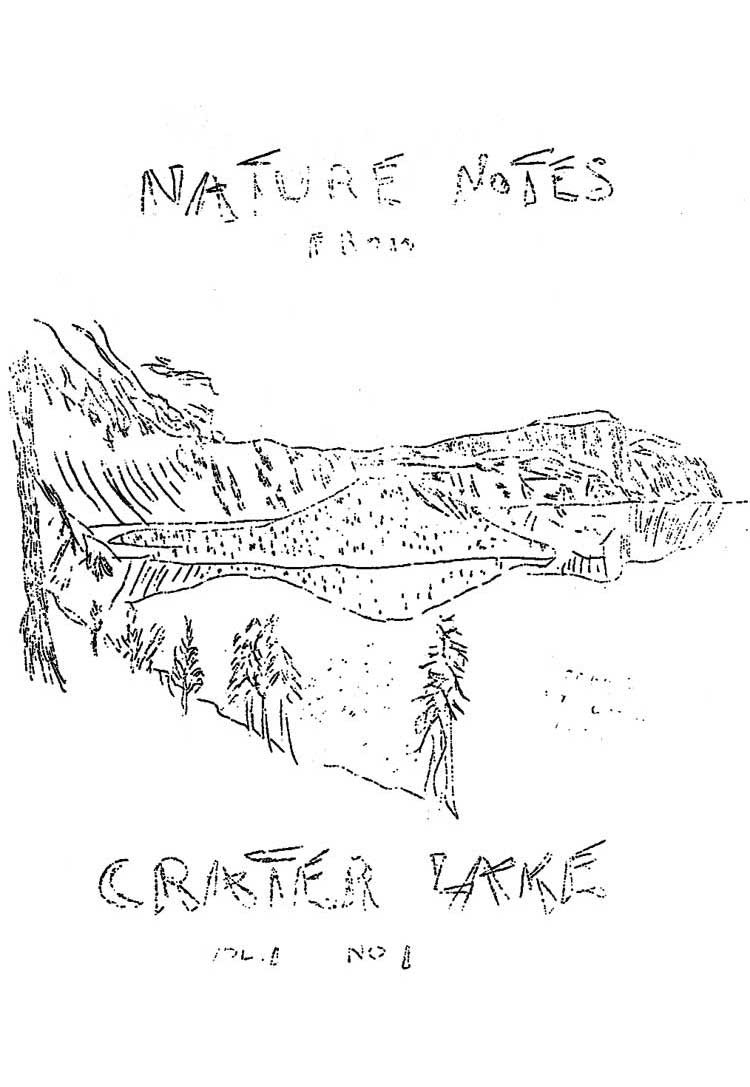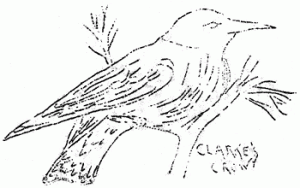
Volume I No. 1 – July 1, 1928All material courtesy of the National Park Service. These publications can also be found at http://npshistory.com/Nature Notes is produced by the National Park Service. © 1928. |
Crater Lake
By Earl U. Homuth
In this, the first issue of the first volume of our “Nature Notes from Crater Lake”, it might be well to describe briefly that marvelous feature which is known as Crater Lake, and to attempt, briefly, to outline the theories as to its origin.
Crater Lake lies in the caldera of a once mighty mountain. The lake is approximately six miles wide and slightly longer; is nearly 2000 feet deep at the deepest sounding; is surrounded by cliffs varying from 500 to over 1800 feet in sheer height.
Many interesting features may be observed on the walls above the lake; ancient valleys on a still more ancient mountain, filled with lava, and then cut in cross-section to show in perfect clearness; broad glacial valleys opening on the very brink of the caldera, indicating again some points in the history of the original peak; cut edges of as many as thirty successive lava flows and other points illustrating the development of Mt. Mazama. Mazama is the name given to the mountain that once stood here. Evidence that a peak did rise a full ten thousand feet above the lake bottom, or a full seven thousand above the Rim, is derived from four sources.
First, glacial evidence is clear, and the source of the glaciers have been higher than the present rim, since there are no cirques, the cut edges of moraines show at the rim, and the valleys are broad and U-shaped at the very top.
Second, dikes stand out boldly on the inside of the walls, indicating an angle toward an original peak. Fully ten of these can be counted.
Third, the slope of the flow of lava is downward, away from the rim on every side, and the walls are largely the broken edges of these flows, not coated over with other lava material.
Fourth, Wizard Island is a true crater rising to approximately eight hundred feet above the water, or considering the depth of the lake, a cone two thousand eight hundred feet from base to summit. Since the action of a crater builds it up, and material was present to build up this cone, then possibly a previous period of volcanic action could have raised Mt. Mazama to a height where it could rival Mt. Shasta, Hood, and others of our great volcanic peaks.
What became of Mt. Mazama will be discussed briefly in a future issue of these notes.
The Pines of Crater Lake
By F. Lyle Wynd
The pines may be distinguished from other conifers by the fact that the leaves, or needles as they are often called, are borne in clusters; and also by the fact that the seeds are borne in cones. This last character may seem self-evident for certainly any tree in the Pine family should have cones. But this popular conception is untrue as evidenced by three members of the Pine family which are found in the Park which do not have cones
The pines are represented by five species in the Park. The most common one is Pinus contorta or Lodgepole Pine. This is a small tree and grows at all altitudes in the Park. This is the scrubby tree that grows so thickly on the level valley plains.
Pinus ponderosa, or the Western wheat Pine, is represented by wonderfully fine specimens on the lower altitudes.
Pinus lambertiana, or the Western Sugar Pine, also grows at the lower altitudes.
The next occurring in respect to elevation is the Western White Pine, or Pinus monticola.
At the highest altitudes the White-barked Pine grows. Botanists know this species as Pinus albicaulis, which means “white-stemmed” and the appearance of the small branches justify this name.
The pines immediately about the Rim are White-Barked Pine.
–
About Flowers
By Earl U. Homuth
The flora of Crater Lake has not been very thoroughly studied, and offers unusual opportunities. This may be due to a comparatively short season, and possibly because other regions are nearer centers of population.
A student from the Univeristy of Oregon, at present collecting in the park, expects to obtain fully five hundred, and possibly seven hundred, species. Seven species were reported as being from Crater Lake only, but a report from the national herbarium invalidates one determination and two others are reported from one station in northern California, while another is found in this region, but outside the park boundaries. The remaining three are Colomium mazama, Cov., Arinaria pumicola, Cov. and Leib, and Eucepahlus covellii, Greene.
A Migrant Tree
By Earl U. Homuth
Joseph Diller in his report on the geology of Crater Lake (Professional Paper, No. 3, Series B. Descriptive Geology, 22), mentions a phenomenon occasionally observed in the lake. A tree becoming dislodged may slide from the cliffs root foremost, and come to rest with the lower portion in the water. The root mass then becomes water-logged, and later the tree may be pushed out into deeper water and will float upright. A tree in this position has occassionally become lodged near the shore again and is often pointed out as evidence that the lake level has risen. Conclusions from one tree would hardly be acceptable, but nevertheless this is often the case.
A tree in the position described is now lodged near the shore of Wizard Island, on the southeast side.
Our Bears
By Earl U. Homuth
Bear signs and bear tracks in the snow were observed during the early season, but the familiar forms of last year have been a bit shy in appearing in public. Excellent photographs of one were obtained by the boat-boys near the hotel. A real bear-fight was staged near Headquarters one evening for the entertainment of all those present. The outcome was not determined, since the battle raged through the woods and over the ridge nearby.
Jemima, who was the well-known Jimmy until she appeard with two cubs last year, has not been seen, and doubts are being expressed as to whether she is still with us.
It is told of one of the rangers that while a guest at the cabin of another ranger, he lost his supply of cooked meat, this being the only way the host could persuade three visiting bears to depart. The points of etiquette as opposed to necessity in such a case may still be open for discussion.
–
Casual Bird Notes
By Earl U. Homuth
Two pairs of mountain bluebirds are known to have nested near the camp on the rim during past years, but neither has been found this year. However, the activities of a pair indicate that a nest may be discovered near the Community House.
A flock of Brewer blackbirds is reported by Ranger Fisher on the rim near the Lodge.
A mating pair of golden eagles was observed southeast of Union Peak in a part of the park rarely visited.
A black-chinned hummingbird is reported from Wizard Island. An observer in the Park has stated that he has seen more humming birds in the park than he had ever seen elsewhere under similar circumstances.
Clarke’s Crow. The young of this bird are now coming from their nests and the continual squalls are making the woods resounds. The fluffy fellows, as large as their parents, are common in the tourist camps. The Oregon or Grey Jays are not often seen near the rim and among the tourists the Clarke’s Crow or Clarke’s Nutcracker has taken the name of camp-robber.
The bird-list for the park for the past two years numbers seventy-five and many may be added.
The Collapse of Mt. Mazama
By Earl U. Homuth
While illustrating for the benefit of a small group on a field trip, the collapse of Mt. Mazama occurred to the satisfaction of all concerned, including the naturalist. The peak had been reconstructed with a pile of loose earth beside the trail. A stick was pushed into the summit of the pile, to produce a crater. This stick passed without resistance into a gopher hole below the intended crater, whereupon the ancient mountain promptly fell in upon itself, leaving a caldera of the proper proportion to serve as the setting for Crater Lake.
“Sulphur” on Crater Lake
By Earl U. Homuth
It is often observed from the Rim above Crater Lake, and from boats on the lake, that great masses of sulphur are floating on the water. This arouses the curiosity of the tourists and explanations are continuously in order. The entire region being of volcanic origin, the conclusion is generally offered that the sulphur is due to this fact. Examination, however, discloses that this wheat substance is pollen, probably of the lodgepole (P. contorta) blown in clouds from a distance and dropped upon the water in significant quantities to be visible from the cliffs above the lake.
Conies on Wizard Island
By Earl U. Homuth
During a trip to Wizard Island several conies were observed. These animals have often been reported from this unusual place. The question has often been raised as to how they got there, since this small crater is separated from the cliffs of the rim by a considerable expanse of water. Many conjectures may be offered, but most of them can hardly be accepted. It is suggested that they crossed on the ice or on snow slides from the cliffs above. There are records of that portion of the lake, between the Island and the nearest cliffs freezing, but this little animal would not be seeking new environments at that time of the year.
Signs of conies may be found near the bottom of the crater on the Island, on the north side, near a cairn which has been piled there. A few moments of waiting will be rewarded. On this occasion one cony was observed at less than three paces.
Other pages in this section
-




